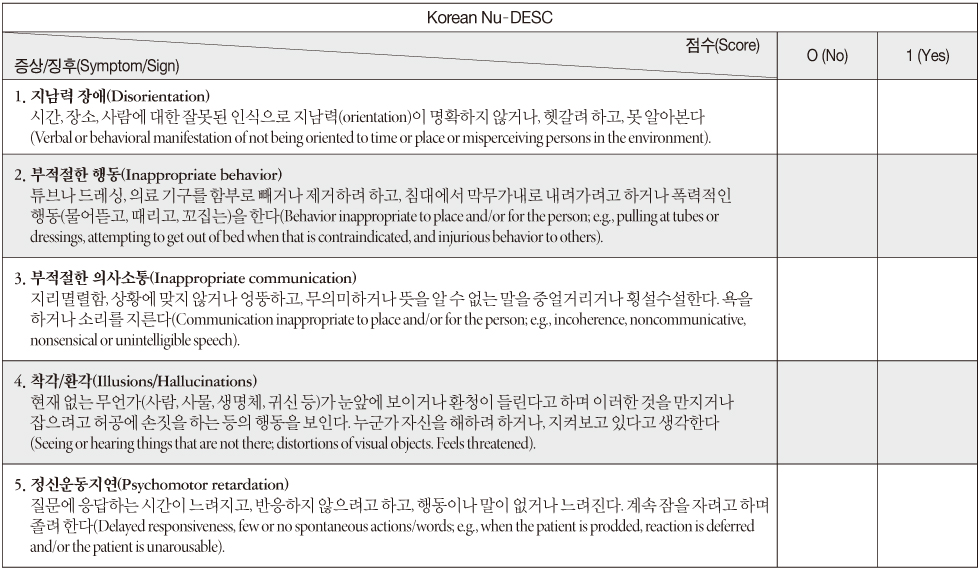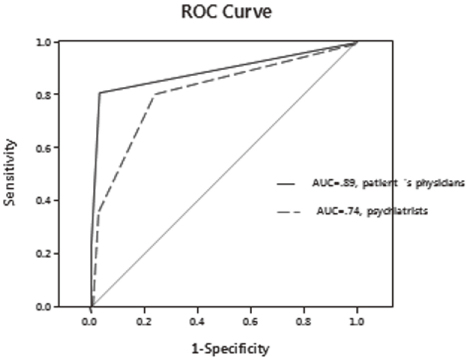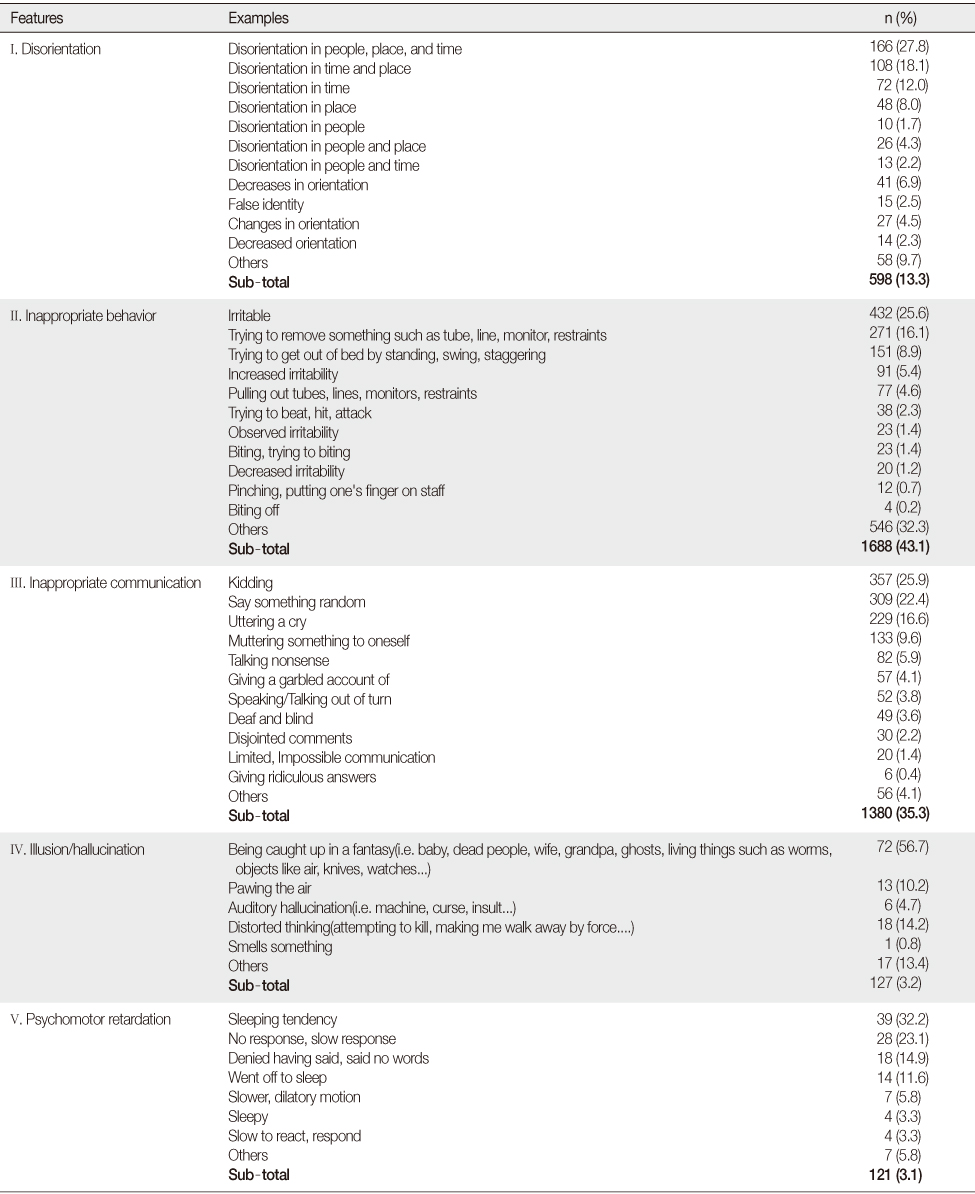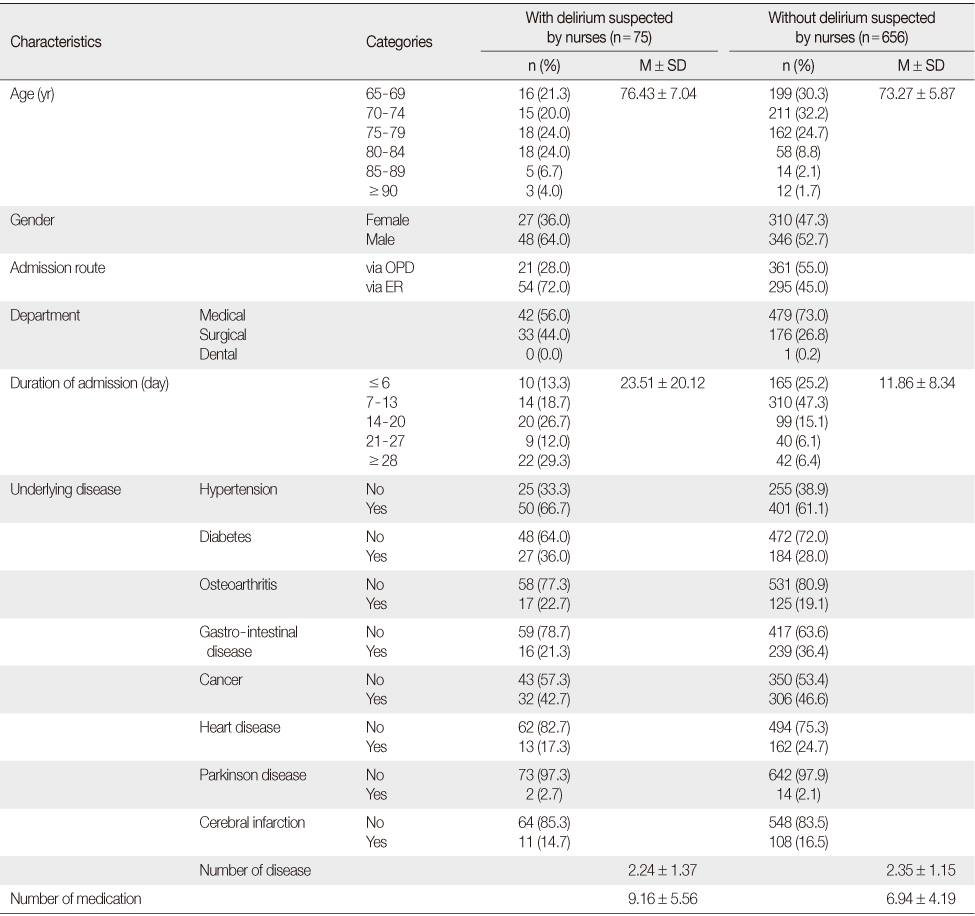Articles
- Page Path
- HOME > J Korean Acad Nurs > Volume 42(3); 2012 > Article
-
Original Article
- Development and validation of the Korean Nursing Delirium Scale
- Kyoung-Nam Kim, Cheol-Ho Kim, Kwang-Il Kim, Hyun-Jung Yoo, Si-Young Park, Yeon-Hwan Park
-
Journal of Korean Academy of Nursing 2012;42(3):414-423.
DOI: https://doi.org/10.4040/jkan.2012.42.3.414
Published online: June 29, 2012
1Assistant Director, Department of Nursing, Seoul National University Bundang Hospital, Bundang, South Korea.
2Professor, Geriatric Center, Seoul National University Bundang Hospital & Department of Internal Medicine, Seoul National University College of Medicine, Bundang, South Korea.
3Associate Professor, Geriatric Center, Seoul National University Bundang Hospital & Department of Internal Medicine, Seoul National University College of Medicine, Bundang, South Korea.
4Coordinator, Geriatric Center, Seoul National University Bundang Hospital, Bundang, South Korea.
5Associate Professor, College of Nursing & The Research Institute of Nurisng Science, Seoul National University, Seoul, South Korea.
- Address reprint requests to: Park, Yeon-Hwan. College of Nursing, Seoul National University, 28 Yeongeon-Dong, Jongro-Gu, Seoul 110-799, South Korea. Tel: +82-2-740-8846, Fax: +82-2-765-4103, hanipyh@snu.ac.kr
© 2012 Korean Society of Nursing Science
- 1,729 Views
- 59 Download
- 30 Crossref
Abstract
-
Purpose
- The aims of this study were to develop and test the validity of the Korean Nursing Delirium Scale (Nu-DESC) for older patients in hospital.
-
Methods
- The Korean Nu-DESC was developed based on the Nu-DESC (Gaudreau, 2005), and revised according to nursing records related to signs and symptoms of older patients with delirium (n=361) and the results of a pilot study (n=42) in one general hospital. To test the validity of the Korean Nu-DESC, 75 older patients whom nurses suspected of delirium from 731 older patients from 12 nursing units were assessed by bedside nurses using the Korean Nu-DESC. A Receiver Operating Characteristic Curve of the Korean Nu-DESC was constructed with an accompanying Area Under the Curve (AUC).
-
Results
- Specific examples such as irritable, kidding, sleeping tendency, which were observed by bedside nurses in Korea, were identified in the five features of signs and symptoms of delirium in the instrument. The Korean Nu-DESC was psycho-metrically valid and had a sensitivity and specificity of .81-.76 and .97-.73, respectively. The AUC were .89, .74.
-
Conclusion
- Results of this study indicate that the Korean Nu-DESC is well-suited for widespread clinical use in busy inpatients settings and shows promise as a research instrument.
This work was supported by research grant from the Geriatric center, Seoul National University Bundang Hospital in 2010.
- 1. Balas MC, Deutschman CS, Sullivan-Marx EM, Strumpf NE, Alston RP, Richmond TS. Delirium in older patients in surgical intensive care units. Journal of Nursing Scholarship. 2007;39:147–154. http://dx.doi.org/10.1111/j.1547-5069.2007.00160.x.ArticlePubMed
- 2. Ely EW, Shintani A, Truman B, Speroff T, Gordon SM, Harrell FE jr, et al. Delirium as a predictor of mortality in mechanically ventilated patients in the intensive care unit. Journal of the American Medical Association. 2004;291:1753–1762. http://dx.doi.org/10.1001/jama.291.14.1753.ArticlePubMed
- 3. Forsgren LM, Eriksson M. Delirium-awareness, observations in intensive care units: A national survey of Swedish ICU head nurses. Intensive and Critical Care Nursing. 2010;26:296–303. http://dx.doi.org/10.1016/j.iccn.2010.07.003.ArticlePubMed
- 4. Gaudreau JD, Gagnon P, Harel F, Tremblay A, Roy MA. Fast, systematic, and continuous delirium assessment in hospitalized patients: The nursing delirium screening scale. Journal of Pain and Symptom Management. 2005;29:368–375. http://dx.doi.org/10.1016/j.jpainsymman.2004.07.009.ArticlePubMed
- 5. Inouye SK. Predisposing and precipitating factors for delirium in hospitalized older patients. Dementia and Geriatric Cognitive Disorder. 1999;10:393–400. http://dx.doi.org/10.1159/000017177.ArticlePDF
- 6. Inouye SK, Foreman MD, Mion LC, Katz KH, Cooney LM Jr. Nurses' recognition of delirium and its symptoms: Comparison of nurse and researcher ratings. Archives of Internal Medicine. 2001;161:2467–2473. http://dx.doi.org/10.1001/archinte.161.20.2467.PubMed
- 7. Kiely DK, Marcantonio ER, Inouye SK, Shaffer ML, Bergmann MA, Yang FM, et al. Persistent delirium predicts greater mortality. Journal of the American Geriatrics Society. 2009;57:55–61. http://dx.doi.org/10.1111/j.1532-5415.2008.02092.x.ArticlePubMedPMC
- 8. Kim AL. Delirium among elderly patients in the intensive care units. 2010;Seoul, Ewha Womans University. Unpublished master's thesis.
- 9. Kim KH, Kho DH, Shin JY, Choi JY, Kim ES, Kim DH. Risk factors of postoperative delirium in elderly patients with hip fractures. Journal of the Korean Fracture Society. 2008;21:189–194.Article
- 10. Lemiengre J, Nelis T, Joosten E, Braes T, Foreman M, Gastmans C, et al. Detection of delirium by bedside nurses using the confusion assessment method. Journal of the American Geriatrics Society. 2006;54:685–689. http://dx.doi.org/10.1111/j.1532-5415.2006.00667.x.ArticlePubMed
- 11. Leung JM, Leung VW, Leung CM, Pan PC. Clinical utility and validation of two instruments (the Confusion Assessment Method Algorithm and the Chinese version of Nursing Delirium Screening Scale) to detect delirium in geriatric inpatients. General Hospital Psychiatry. 2008;30:171–176. http://dx.doi.org/10.1016/j.genhosppsych.2007.12.007.ArticlePubMed
- 12. McCusker J, Cole MG, Voyer P, Monette J, Champoux N, Ciampi A, et al. Use of nurse-observed symptoms of delirium in long-term care: Effects on prevalence and outcomes of delirium. International Psychogeriatrics. 2011;23:602–608. http://dx.doi.org/10.1017/S1041610210001900.ArticlePubMed
- 13. Micek ST, Anand NJ, Laible BR, Shannon WD, Kollef MH. Delirium as detected by the CAM-ICU predicts restraint use among mechanically ventilated medical patients. Critical Care Medicine. 2005;33:1260–1265. http://dx.doi.org/10.1097/01.CCM.0000 164540.58515.BF.ArticlePubMed
- 14. Milisen K, Steeman E, Foreman MD. Early detection and prevention of delirium in older patients with cancer. European Journal of Cancer Care. 2004;13:494–500. http://dx.doi.org/10.1111/j.1365-2354.2004.00545.x.ArticlePubMed
- 15. Morandi A, Jackson JC, Ely EW. Delirium in the intensive care unit. International Review of Psychiatry. 2009;21:43–58. http://dx.doi.org/10.1080/09540260802675296.ArticlePubMed
- 16. Ouimet S, Kavanagh BP, Gottfried SB, Skrobik Y. Incidence, risk factors and consequences of ICU delirium. Intensive Care Medicine. 2007;33:66–73. http://dx.doi.org/10.1007/s00134-006-0399-8.ArticlePubMedPDF
- 17. Peterson JF, Pun BT, Dittus RS, Thomason JW, Jackson JC, Shintani AK, et al. Delirium and its motoric subtypes: A study of 614 critically ill patients. Journal of the American Geriatrics Society. 2006;54:479–484. http://dx.doi.org/10.1111/j.1532-5415.2005.00621.x.ArticlePubMed
- 18. Pisani MA, Murphy TE, Araujo KL, Slattum P, Van Ness PH, Inouye SK. Benzodiazepine and opioid use and the duration of intensive care unit delirium in an older population. Critical Care Medicine. 2009;37:177–183. http://dx.doi.org/10.1097/CCM.0b013e318 192fcf9.ArticlePubMed
- 19. Pitkälä KH, Laurila JV, Strandberg TE, Tilvis RS. Multicomponent geriatric intervention for elderly inpatients with delirium: A randomized, controlled trial. The Journals of Gerontology. Series A, Biological Sciences and Medical Sciences. 2006;61:176–181.ArticlePubMed
- 20. Schreier AM. Nursing care, delirium, and pain management for the hospitalized older adult. Pain Management Nursing. 2010;11:177–185. http://dx.doi.org/10.1016/j.pmn.2009.07.002.ArticlePubMed
- 21. Schuurmans MJ, Duursma SA, Shortridge-Baggett LM. Early recognition of delirium: Review of the literature. Journal of Clinical Nursing. 2001;10:721–729. http://dx.doi.org/10.1111/j.1365-2702.2001.00548.x.ArticlePubMed
- 22. Souder E, O'Sullivan PS. Nursing documentation versus standardized assessment of cognitive status in hospitalized medical patients. Applied Nursing Research. 2000;13:29–36. http://dx.doi.org/10.1016/S0897-1897(00)80016-6.ArticlePubMed
- 23. Steis MR, Fick DM. Are nurses recognizing delirium? A systematic review. Journal of Gerontological Nursing. 2008;34:40–48.Article
- 24. Swets JA. Measuring the accuracy of diagnostic systems. Science. 1988;240:1285–1293. http://dx.doi.org/10.1126/science.3287615.ArticlePubMed
- 25. Trzepacz PT, Mittal D, Torres R, Kanary K, Norton J, Jimerson N. Validation of the delirium rating scale-revised-98: Comparison with the delirium rating scale and the cognitive test for delirium. The Journal of Neuropsychiatry and Clinical Neurosciences. 2001;13:229–242. http://dx.doi.org/10.1176/appi.neuropsych.13.2.229.ArticlePubMed
- 26. Voyer P, Richard S, Doucet L, Danjou C, Carmichael PH. Detection of delirium by nurses among long-term care residents with dementia. BMC Nursing. 2008;7:4. http://dx.doi.org/10.1186/1472-6955-7-4.PubMedPMC
- 27. Wei LA, Fearing MA, Sternberg EJ, Inouye SK. The confusion assessment method: A systematic review of current usage. Journal of the American Geriatrics Society. 2008;56:823–830. http://dx.doi.org/10.1111/j.1532-5415.2008.01674.x.ArticlePubMedPMC
- 28. Yang YH. Comprehension and knowledge about delirium in nurses working at long-term care hospitals or general hospitals. Journal of Korean Academic Society of Nursing Education. 2010;16:312–320.Article
- 29. Yu KD, Lee TJ, Suh YW, Chung SH, Kim EY, Kim HY, et al. Delirium in acute elderly care unit: Prevalence, clinical characteristics, risk factors and prognostic significance. Journal of the Korean Geriatrics Society. 2005;9:182–189.
REFERENCES
Figure & Data
REFERENCES
Citations

- Prevention of Unbearable Situations and Harms Protocol: A Quality Improvement Initiative in Neurological Delirium
Mi Sun Kim, Sungyang Jo, Hyung Ja Kim, Sun Young Pyun, Seonok Kim, Sun Mae Park, Yong Seo Koo
Journal of Clinical Neurology.2025; 21(6): 536. CrossRef - Risk factors for postoperative delirium in patients with cardiac surgery
Min-Song Kim, Sang-Hee Kim
Science Progress.2024;[Epub] CrossRef - Extracellular Vesicle MicroRNAs as Predictive Biomarkers in Postoperative Delirium After Spine Surgery: Preliminary Study
Young-Eun Cho, Jeongmin Kim, Rany Vorn, Hyeonmi Cho, Wonhee Baek, Hyunki Park, Sijung Yun, Hyung-Suk Kim, Ann K Cashion, Jessica Gill, Bon-Nyeo Koo, Hyangkyu Lee, Gustavo Duque
The Journals of Gerontology, Series A: Biological Sciences and Medical Sciences.2024;[Epub] CrossRef - Assessment of Risk Factors for Postoperative Delirium in Older Adults Who Underwent Spinal Surgery and Identifying Associated Biomarkers Using Exosomal Protein
Wonhee Baek, JuHee Lee, Yeonsoo Jang, Jeongmin Kim, Dong Ah Shin, Hyunki Park, Bon-Nyeo Koo, Hyangkyu Lee
Journal of Korean Academy of Nursing.2023; 53(4): 371. CrossRef - The Relationship between Perioperative Blood Transfusion and Postoperative Delirium in Patients Undergoing Spinal Fusion Surgery: Clinical Data Warehouse Analysis
Young-Suk Kwon, Jong-Ho Kim, Jae-Jun Lee, Eun-Min Seo
Medicina.2022; 58(2): 268. CrossRef - The Effect of Korean Medicine Treatment for Hemorrhagic Transformation after Interventional Reperfusion Therapy of an Anterior Circulation Infarction in a Patient with Hemiplegia and Conscious and Cognitive Disorders: A Case Report
Chae-eun Kim, Ji-hyeon Kang, Seo-hyun Kim, Jun-seok Kim, Kyung-min Baek
The Journal of Internal Korean Medicine.2022; 43(6): 1274. CrossRef - Preoperative Inflammatory Markers and the Risk of Postoperative Delirium in Patients Undergoing Lumbar Spinal Fusion Surgery
Jin Seo Yang, Jae Jun Lee, Young-Suk Kwon, Jong-Ho Kim, Jong-Hee Sohn
Journal of Clinical Medicine.2022; 11(14): 4085. CrossRef - Geriatric assessment predicts nonfatal toxicities and survival for intensively treated older adults with AML
Gi-June Min, Byung-Sik Cho, Sung-Soo Park, Silvia Park, Young-Woo Jeon, Seung-Hwan Shin, Seung-Ah Yahng, Jae-Ho Yoon, Sung-Eun Lee, Ki-Seong Eom, Yoo-Jin Kim, Seok Lee, Chang-Ki Min, Seok-Goo Cho, Dong-Wook Kim, Jong Wook Lee, Kim Hee-Je
Blood.2022; 139(11): 1646. CrossRef - A Case Report of Elderly Delirium Treated with
Shihogayonggolmoryo-tang
Su-jung Lee, Ji-soo Yang, Eun-chai Cho, Jae-hwan Lew
The Journal of Internal Korean Medicine.2022; 43(2): 144. CrossRef - Incidence and Risk Factors of Postoperative Recovery Room Delirium in Elderly Patients after Surgery under General Anesthesia
Eunjung Choi, Ye-Eun Seo, Hyun-Sook Yoo, Dong Yeon Kim
Korean Journal of Adult Nursing.2022; 34(2): 215. CrossRef - Validation of the Simplified Palliative Prognostic Index to Predict Survival for Advanced Cancer Patients in Home Hospice Setting
Hyeon-Jeong Yang, Seok-Joon Yoon, Jong-Sung Kim, Sung-Soo Kim, Jin-Gyu Jung, Won Yoon Suh, Sami Lee, Hyun Gu Kim, Yong Woo Lee
Korean Journal of Family Medicine.2021; 42(4): 274. CrossRef - Prevalence and Predictive Factors for Upfront Dose Reduction of the First Cycle of First-Line Chemotherapy in Older Adults with Metastatic Solid Cancer: Korean Cancer Study Group (KCSG) Multicenter Study
In Gyu Hwang, Minsuk Kwon, Jin Won Kim, Se Hyun Kim, Yun-Gyoo Lee, Jin Young Kim, Su-Jin Koh, Yoon Ho Ko, Seong Hoon Shin, Soojung Hong, Tae-Yong Kim, Sun Young Kim, Hyun Jung Kim, Hyo Jung Kim, Myung Ah Lee, Jung Hye Kwon, Yong Sang Hong, Kyung Hee Lee,
Cancers.2021; 13(2): 331. CrossRef - Factors Associated with the Fear of Falling after Discharge in Older Adults Who had Surgery after Experiencing a Fall Fracture
Jin-Yeong Kim, Gwi-Ryung Son Hong
Journal of Korean Gerontological Nursing.2021; 23(4): 395. CrossRef - A single-arm feasibility study of gradual dose de-escalation of antiemetic dexamethasone for older patients receiving chemotherapy
Koung Jin Suh, Seonghae Yoon, Jin Won Kim, Seo Hyun Yoon, Ji-Won Kim, Se Hyun Kim, Yu Jung Kim, Keun-Wook Lee, Jong Seok Lee, Jee Hyun Kim
Journal of Geriatric Oncology.2021; 12(6): 922. CrossRef - Effects of Increased Optic Nerve Sheath Diameter on Inadequate Emergence from Anesthesia in Patients Undergoing Robot-Assisted Laparoscopic Prostatectomy: A Prospective Observational Study
Yu Jeong Bang, Heejoon Jeong, Burn Young Heo, Byung Seop Shin, Woo Seog Sim, Duk-Kyung Kim, Sang Hyun Lee, Ji Su Kim, Young Hee Shin
Diagnostics.2021; 11(12): 2260. CrossRef - Diagnostic test accuracy of the Nursing Delirium Screening Scale: A systematic review and meta‐analysis
Eunhye Jeong, Jinkyung Park, Juneyoung Lee
Journal of Advanced Nursing.2020; 76(10): 2510. CrossRef - Nursing Delirium Screening Scale, a Tool for Early Detection of Delirium: Integrative Review
Angela María Henao-Castaño, Laura Elizabeth Pachón Cetina, Juan David Monroy Rodríguez
Aquichan.2020; 20(4): 1. CrossRef - Delirium screening in patients in a palliative care ward: a best practice implementation project
Xiao Bin Lai, Zhe Huang, Chun Yan Chen, Matthew Stephenson
JBI Database of Systematic Reviews and Implementation Reports.2019; 17(3): 429. CrossRef - Predictors for Incidence of Delirium after Musculoskeletal Operation in Elderly Patients
Unjong Choi, Sun Ja Kim, Ji Sook Kang
Stress.2019; 27(2): 139. CrossRef - Prevalence of Delirium and Risk Factors in Heart Surgery Patients in Intensive Care Unit: A Retrospective study
Eun-Young Noh, Yeon-Hwan Park
Korean Journal of Adult Nursing.2019; 31(2): 146. CrossRef - Effects of Delirium Management Program on Nursing Practice and Nurses' Stress in Comprehensive Nursing Care Service Units
Ji Hye Kim, Sook Young Kim
The Korean Journal of Rehabilitation Nursing.2019; 22(2): 114. CrossRef - The Incidence and Related Risk Factors of Delirium in the Older Inpatients with Neurological Disorders in a Tertiary Hospital
Mi Sun Kim, Ji Yoon Jun, Hyun Ju Chun, Yun Ok Kim
Korean Journal of Adult Nursing.2018; 30(3): 255. CrossRef - Nurses' Awareness of Psychological Distress and Delirium in Cancer Patients and Job Stress
Mi Ae Park, Eunsook Choi
Asian Oncology Nursing.2017; 17(4): 252. CrossRef - Delirium Management: Diagnosis, Assessment, and Treatment in Palliative Care
Min Seok Seo, Yong Joo Lee
The Korean Journal of Hospice and Palliative Care.2016; 19(3): 201. CrossRef - Development of Korean Intensive Care Delirium Screening Tool (KICDST)
Ae-Ri-Na Nam, Jee-Won Park
Journal of Korean Academy of Nursing.2016; 46(1): 149. CrossRef - Postoperative Delirium in Elderly Patients with Osteoarthritis Surgery: Incidence and Risk Factors
Eun A Park, Min Young Kim
Journal of muscle and joint health.2015; 22(2): 57. CrossRef - Effects of Family Presence Intervention on Anxiety, Delirium, Pain and Length of Time in Recovery Room of Post-operative Elderly Patients in Post-anesthesia Care Units
Kyunghee Kim, Sookhee Lee
Journal of Korean Academy of Fundamentals of Nursing.2015; 22(2): 149. CrossRef - Evaluation of Clinical Usefulness of Delirium Assessment Tools for Elderly Patients after Neurosurgery
Su-Jung Kim, Jun-Ah Song
Journal of Korean Gerontological Nursing.2015; 17(1): 38. CrossRef - Validity of Instrument Development Research in Korean Nursing Research
Kyunghee Lee, Sujin Shin
Journal of Korean Academy of Nursing.2013; 43(6): 697. CrossRef - Comparison of Delirium Screening Instruments for the Elderly
Young Whee Lee, Sung Ok Chang, Eun Suk Kong, Nam Cho Kim, Chun Gill Kim, Hee Kyung Kim, Misoon Song, Soo Yeon Ahn, Myung Ok Cho, Kyung Sook Choi
Korean Journal of Adult Nursing.2013; 25(6): 655. CrossRef
- Figure
- We recommend
- Related articles
-
- Development and Psychometric Evaluation of the Ischemic Stroke Distress Scale (ISDS)
- Development and Evaluation of Evidence-Based Nursing Protocol for Extracorporeal Membrane Oxygenation to Critically Ill Patients
- The Reliability and Validity of the Korean Version of the 5C Psychological Antecedents of Vaccination Scale
- Development and Validation of a Dignity in Care Scale of Terminally Ill Patients for Nurses
- Development of Nursing Clinical Judgment Scale


Figure 1
Figure 2
Specific Examples of Five Features in Sign and Symptoms of Delirium (N=361)
General Characteristics of Older Patients in the 3rd Step (N=731)
OPD=Out patient department; ER=Emergency room.
Validation of the Korean Nursing Delirium Scale (Nu-DESC) (N=75)
AUG=Area under the curve; CI=Confidence interval.
OPD=Out patient department; ER=Emergency room.
AUG=Area under the curve; CI=Confidence interval.
 KSNS
KSNS
 E-SUBMISSION
E-SUBMISSION





 Cite
Cite

